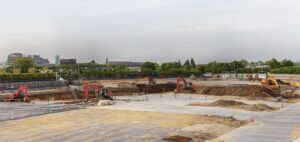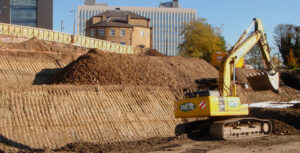
Land reclamation refers to the process of creating new land from oceans, seas, riverbeds, or other water bodies. Historically, land reclamation has played a crucial role in expanding usable land for agriculture, urban development, and industrial use, particularly in regions where natural land is scarce. Over the centuries, various countries have undertaken significant land reclamation projects, with notable examples in the Netherlands, Japan, Singapore, and Hong Kong. These projects have transformed landscapes and provided much-needed space for growing populations and economic activities.
Land reclamation involves converting water-covered or otherwise unusable land into areas fit for agricultural, industrial, or urban use. This process transforms environments like wetlands, deserts, and coastal regions into habitable and productive land. Unlike land restoration, which focuses on returning degraded land to its natural state, land reclamation often involves extensive engineering and construction efforts to create new land where none previously existed.
While land reclamation focuses on creating new land from water bodies, land restoration aims to return disturbed or degraded land to its natural or usable state. Restoration often involves ecological rehabilitation, whereas reclamation is primarily about land creation.
Extending coastlines to create new land from the sea is a method often used in countries with limited land availability, such as the Netherlands and Japan. This method often involves constructing barriers such as sea walls and then filling the enclosed area with materials like sand or soil.
Redirecting and managing river systems to prevent flooding and create new land. By controlling river flow and sediment deposition, new land can be formed along riverbanks, which can be used for agriculture, housing, or other purposes.
Draining wetlands to make them suitable for agriculture or urban development. This involves removing water from wetlands through pumping or constructing drainage systems, converting the area into usable land. However, this type can have significant ecological impacts, as wetlands are crucial habitats for many species.
Restoring land that has been degraded by mining activities, making it suitable for new uses. This process includes reshaping the land, replacing topsoil, and replanting vegetation to stabilize the soil and restore the ecosystem.

One of the oldest methods involves filling areas with vast quantities of soil, sand, or other materials. This approach, known as “land fill,” has been used extensively in places like Hong Kong and Singapore to expand urban areas. It involves transporting fill material to the reclamation site and layering it until the desired elevation is reached.
Building sea walls and dykes helps protect reclaimed areas from sea encroachment, maintaining the integrity of the new land. These structures act as barriers against waves and tides, allowing the enclosed area to be drained and filled. Sea walls and dykes are essential for coastal reclamation projects, providing long-term protection against erosion and flooding.
Dredging involves raising the seabed or riverbed, making it possible to reclaim underwater areas. This method removes sediment from the bottom of water bodies and deposits it in designated areas to create new land. Dredging is often used in conjunction with other techniques to ensure stability and sustainability, particularly in riverine and coastal reclamation projects.
Today, innovations such as geo-textiles and eco-friendly materials are making land reclamation more sustainable. Geo-textiles are permeable fabrics used to reinforce soil and prevent erosion, while eco-friendly materials reduce the environmental footprint of reclamation projects. These advancements minimize environmental impact and enhance the durability of reclaimed land, ensuring that it remains stable and productive over the long term.
Reclaimed land provides much-needed space for expanding cities, enabling the development of new housing, commercial areas, and infrastructure. As urban populations grow, the demand for land increases, making reclamation an essential strategy for accommodating this growth and preventing urban sprawl.
In some cases, land reclamation can restore environments, creating new habitats and improving ecological balance. For instance, reclaimed wetlands can serve as new habitats for wildlife, while restored mined lands can support vegetation and reduce soil erosion.
Reclaiming land boosts local economies by creating real estate opportunities, attracting tourism, and supporting commercial developments. Notable examples include the Marina Bay in Singapore, which has become a major financial and tourist hub, and the Kansai International Airport in Japan, built on reclaimed land to enhance connectivity and economic growth.
One major concern is the disruption of marine ecosystems and loss of natural habitats, which can have far-reaching consequences for biodiversity. Land reclamation can lead to the destruction of coral reefs, mangroves, and other critical habitats, affecting marine life and water quality.
Reclaiming land can lead to community displacement, high costs, and sustainability issues. These challenges require careful planning and management to mitigate adverse effects. For example, relocating residents from reclaimed areas can be socially and economically disruptive, and the high cost of reclamation projects can strain public finances.
Reclaiming land can spark legal and international disputes over territorial waters. Countries may contest the ownership of newly reclaimed land, leading to diplomatic tensions and conflicts. It is essential to navigate these challenges through diplomacy and adherence to international laws, ensuring fair and peaceful resolution of disputes.
Finding a balance between development and conservation is critical. Sustainable practices must be prioritized to ensure long-term benefits without compromising environmental health. This involves adopting methods that minimize ecological impact and integrating conservation efforts into reclamation projects.
Future land reclamation efforts will likely focus on sustainability, employing cutting-edge technologies and eco-friendly practices to minimize environmental impact. Innovations such as bioengineering, renewable energy integration, and circular economy principles will make reclamation projects more sustainable and resilient.
Effective policies and international cooperation will be vital in addressing the complex issues surrounding land reclamation. Collaborative efforts can lead to shared benefits and reduced conflicts, fostering a global approach to sustainable development. International guidelines and agreements can help ensure that reclamation projects are carried out responsibly and equitably.
Climate change poses new challenges for reclaimed lands, including rising sea levels and extreme weather events. Anticipating and adapting to these changes will be crucial for the future success of reclamation projects. Strategies such as building climate-resilient infrastructure, enhancing coastal defenses, and implementing adaptive management practices will be essential in mitigating the impacts of climate change.

Land reclamation remains a powerful tool for development and environmental management. As we look to the future, adopting sustainable practices and adhering to international guidelines is essential. By doing so, we can continue to benefit from land reclamation while maintaining a harmonious relationship with our environment. G3SoilWorks is dedicated to advancing sustainable land reclamation practices, ensuring we can responsibly expand our horizons while protecting our planet. Want to know more about what is land reclamation? Call us at +1 714-668-5600.
1. What are some unexpected benefits of land reclamation?
A: Land reclamation can lead to unexpected benefits such as the creation of recreational spaces and parks, which provide green areas for communities and enhance the quality of urban life. Additionally, it can help in flood management by creating barriers and reservoirs that control water flow and reduce the risk of flooding.
2. How does land reclamation affect local wildlife?
A: While land reclamation can disrupt existing ecosystems, it also has the potential to create new habitats. For instance, artificial wetlands developed through reclamation can support a diverse range of flora and fauna, contributing to biodiversity conservation in previously uninhabitable areas.
3. What are some innovative technologies used in modern land reclamation?
A: Innovative land reclamation technologies include using geo-textiles for soil stabilization, GPS and sonar systems for precise dredging, and eco-friendly materials to reduce environmental impact. These advancements help make the reclamation process more efficient, sustainable, and less intrusive to natural habitats.
Follow, engage, learn. Stop by our blog to see what’s happening at G3SoilWorks.
G3Soilworks – a full service geotechnical/ engineering geologic consulting firm serving clients since 2009 and delivering expert solutions with our highly experienced team and specialized consultants.
G3SoilWorks
350 Fischer Avenue Costa Mesa, CA 92626
Tel. 714.668.5600
E. info@g3soilworks.com